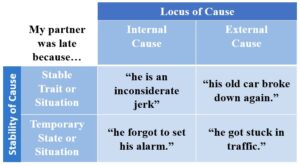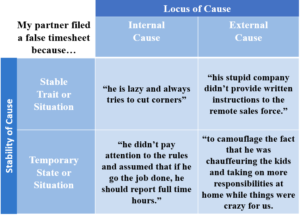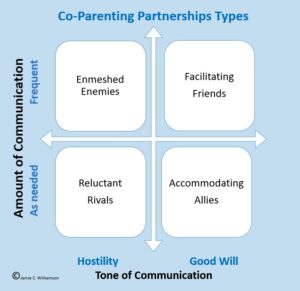When Your Partner Makes Mistakes, Your Attributions Make a Big Difference
By Jamie C. Williamson, PhD
People in long-term relationships make mistakes. The impact your partner’s mistakes have on your relationship depends largely on how you make sense of why they behave as they did. We call this an “attribution” of cause.
And, what you see as the cause when your partner makes mistakes depends mostly on what you look for.
Attributions for Simple Everyday Mistakes
Let’s say your partner made a simple, everyday life kind of mistake like arriving late to pick you up. There are four basic casual attributions you could make for this mistake, and they vary as having resulted from Internal vs External causes and from Stable versus Temporary causes.
My Partner was late because:
- …he is an inconsiderate jerk (Internal, Stable attribution)
- …he forgot to set his alarm (Internal, Temporary attribution)
- …his old car broke down again (External, Stable attribution)
- …he got stuck in traffic (External, Temporary attribution)
People in healthy, satisfying relationships routinely make External, Temporary attributions (#4 – a temporary situation he did not cause) for their partner’s mistakes. These attributions reduce distress about the mistake and promote the well-being of the relationship over time.
People in distressed relationships are more likely to make Internal, Stable attributions (#1 – a negative character trait) for their partner’s mistakes. These attributions exacerbate the stress about the mistake and erode relationship satisfaction over time.
Attributions for a Serious Mistake
Let’s consider a serious life-event stressor: Scott gets fired from his high-paying, work-from-home job because he is not actually working the hours he reports on his timesheet. Lori, who works outside the home, is upset because Scott lost his job (and income) and because he lied to his boss and her about the amount of time he was working. Scott has profusely apologized.
Lori contacted me for help in deciding what to do. First, I acknowledged that it was wrong for Scott to submit a false timesheet to his boss and that his apology seems heartfelt. Then, I explained that the relationship impact of this mistake will depend largely on Lori’s attribution for the cause of the mistake.
I created a diagram showing four different explanatory attributions and asked her which one best explained why she thought Scott was working fewer hours than he reported to his boss and to her.
My partner filed a false timesheet because:
- …he is lazy and always tries to cut corners. (an Internal, Stable Attribution)
- …he didn’t pay close attention to the rules and assumed that when working remotely if he got the job done, he should report full-time hours. (an Internal Temporary Attribution)
- …his stupid company didn’t provide written instructions to the remote sales force. (an External, Stable Attribution)
- …to camouflage the fact that he was stuck chauffeuring the kids around and taking care of more responsibilities at home while things were crazy for us (an External, Temporary Attribution)
If Lori believed that Scott filed a false timesheet because he is lazy and always tries to cut corners, and she reacts to Scott’s job loss through that lens, then Scott’s mistake will likely lead to severe relationship distress, regardless of how many times he apologizes. Lori won’t hear his apology, because, in her view, the job loss is due to Scott’s negative character trait – laziness.
But what if Lori chose to believe that Scott had good intentions, even though he did the wrong thing? She could attribute his mistake to an External, Temporary cause (#4) and determine that he was just trying to keep too many balls in the air – to keep his compensation high, while taking on more family responsibilities, ultimately to make things easier for Lori.
Bottom line:
When your partner makes mistakes, what you see depends on what you look for.
If you find yourself looking for external, temporary causes for your partner’s mistakes, then you will see the positive intentions in your partner’s behavior, even though you acknowledge the mistake. This will make it easier for you to accept your partner’s apology and to cooperate in finding a solution to a serious mistake.
This pattern signals a healthy relationship, likely to survive the mistake and make you closer once you’ve worked together on the solution.
If you find yourself looking for internal, stable causes for your partner’s mistakes, you will see selfish motives for your partner’s behavior, blame your partner for the negative impact on you and your relationship, and resist cooperating in finding a solution.
This pattern signals relationship distress that needs to be addressed. You’ll have several options, depending on your level of overall relationship dissatisfaction.
Let me know if I can help.
You’ll find me at Amity Mediation Workshop, LLC, where we specialize in “friendly divorce” mediation and marriage revitalization sessions and programs using a practical, psycho-educational approach grounded in the Gottman Method. I also speak frequently on relationship topics and author the blog “Work it Out” and write a monthly column for PCB Life Community Newspaper.
















 Each of these insightful suggestions have merit but sometimes they create a conundrum for even the most devoted fathers. For example, how does a busy Dad balance investing ample time with his children with investing quality time in his relationship with their mother – his wife?
Each of these insightful suggestions have merit but sometimes they create a conundrum for even the most devoted fathers. For example, how does a busy Dad balance investing ample time with his children with investing quality time in his relationship with their mother – his wife? specific infraction your spouse made.
specific infraction your spouse made.